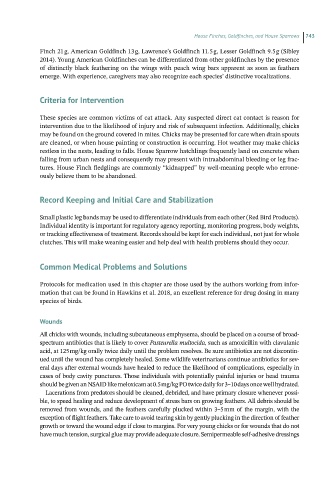Page 741 - Hand rearing birds second
P. 741
House Finches, Goldfinches, and House Sparrows 743
Finch 21 g, American Goldfinch 13 g, Lawrence’s Goldfinch 11.5 g, Lesser Goldfinch 9.5 g (Sibley
2014). Young American Goldfinches can be differentiated from other goldfinches by the presence
of distinctly black feathering on the wings with peach wing bars apparent as soon as feathers
emerge. With experience, caregivers may also recognize each species’ distinctive vocalizations.
Criteria for Intervention
These species are common victims of cat attack. Any suspected direct cat contact is reason for
intervention due to the likelihood of injury and risk of subsequent infection. Additionally, chicks
may be found on the ground covered in mites. Chicks may be presented for care when drain spouts
are cleaned, or when house painting or construction is occurring. Hot weather may make chicks
restless in the nests, leading to falls. House Sparrow hatchlings frequently land on concrete when
falling from urban nests and consequently may present with intraabdominal bleeding or leg frac-
tures. House Finch fledglings are commonly “kidnapped” by well‐meaning people who errone-
ously believe them to be abandoned.
Record Keeping and Initial Care and Stabilization
Small plastic leg bands may be used to differentiate individuals from each other (Red Bird Products).
Individual identity is important for regulatory agency reporting, monitoring progress, body weights,
or tracking effectiveness of treatment. Records should be kept for each individual, not just for whole
clutches. This will make weaning easier and help deal with health problems should they occur.
Common Medical Problems and Solutions
Protocols for medication used in this chapter are those used by the authors working from infor-
mation that can be found in Hawkins et al. 2018, an excellent reference for drug dosing in many
species of birds.
Wounds
All chicks with wounds, including subcutaneous emphysema, should be placed on a course of broad‐
spectrum antibiotics that is likely to cover Pasteurella multocida, such as amoxicillin with clavulanic
acid, at 125 mg/kg orally twice daily until the problem resolves. Be sure antibiotics are not discontin-
ued until the wound has completely healed. Some wildlife veterinarians continue antibiotics for sev-
eral days after external wounds have healed to reduce the likelihood of complications, especially in
cases of body cavity punctures. Those individuals with potentially painful injuries or head trauma
should be given an NSAID like meloxicam at 0.5 mg/kg PO twice daily for 3–10 days once well hydrated.
Lacerations from predators should be cleaned, debrided, and have primary closure whenever possi-
ble, to speed healing and reduce development of stress bars on growing feathers. All debris should be
removed from wounds, and the feathers carefully plucked within 3–5 mm of the margin, with the
exception of flight feathers. Take care to avoid tearing skin by gently plucking in the direction of feather
growth or toward the wound edge if close to margins. For very young chicks or for wounds that do not
have much tension, surgical glue may provide adequate closure. Semipermeable self‐adhesive dressings

